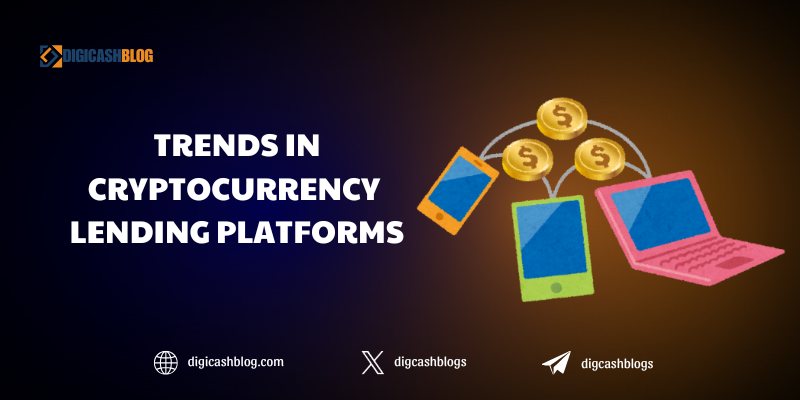Introduction to Crypto Lending Platforms
Cryptocurrency lending platforms, both centralized (CeFi) and decentralized (DeFi), have become pivotal in the $2.66 trillion crypto market, enabling users to earn passive income or access liquidity without selling assets. In 2025, trends in cryptocurrency lending platforms are driven by technological advancements, regulatory clarity, and growing institutional interest. With DeFi lending accounting for 47.4% of total value locked (TVL) in 2021 and continued growth, platforms like Aave, Nexo, and Binance are shaping the future of finance. This article explores key trends, their drivers, and challenges, offering insights for researchers and investors.
Trends in Cryptocurrency Lending Platforms
Rise of DeFi Lending and Smart Contracts
DeFi lending platforms, such as Aave and Compound, are gaining traction over CeFi, with TVL exceeding $150 billion in 2025. These platforms leverage smart contracts for transparent, intermediary-free loans, supporting assets like Ethereum, USDC, and DAI. Aave’s flash loans, enabling uncollateralized borrowing within a single transaction, are popular for arbitrage, with borrowing APY as low as 0.29%. X posts highlight innovations like risk/yield tranching and fixed-rate borrowing on platforms like Jupiter Lend, launching on Solana in July 2025, reflecting DeFi’s growing sophistication.

AI Integration for Enhanced Lending
Artificial intelligence (AI) is transforming lending platforms by optimizing risk assessments and personalizing loan terms. In 2025, protocols like Lido integrate AI to analyze on-chain data, offering tailored interest rates and reducing default risks. X posts note AI-driven features like reputation-based rates and stake-to-reduce-interest models (e.g., RUNE/RUJI), enhancing capital efficiency. This trend aligns with the $40 billion AI token market, boosting platforms’ ability to process large datasets for fairer lending.
Stablecoin Dominance in Lending
Stablecoins, like USDT and USDC, dominate lending due to their stability, with 61.8% of South America’s crypto volume tied to stablecoins. Platforms like Nexo offer up to 16% APR on stablecoin deposits, paid daily, while YouHodler provides 97% loan-to-value (LTV) ratios, the highest in the market. Stablecoins facilitate low-risk lending, especially in volatile regions, with Binance supporting flexible and fixed-rate loans for stablecoin collateral. This trend supports cross-border lending and financial inclusion.
Bitcoin-Backed Lending Growth
Bitcoin collateralized lending is booming, with platforms like Strike’s Twenty One and Zest Protocol emerging in 2025. These use multisig wallets and smart contracts for trustless loan issuance and liquidations, as noted in X posts. With $2 trillion in Bitcoin largely untapped, platforms offer up to 75% LTV for BTC-backed loans, disbursed in USD or USDC, catering to holders seeking liquidity without selling.
Cross-Chain and Interoperability Solutions
Improved interoperability is a key trend, with platforms like Aave supporting 17 blockchains, including Ethereum, Arbitrum, and Avalanche. Cross-chain lending enables seamless asset transfers, reducing fees and enhancing liquidity. X posts highlight TakerLend on TakerChain, focusing on Bitcoin liquid staking derivatives (LSDs), and Jupiter Lend’s cross-chain liquidity solutions on Solana. This trend supports diverse collateral options and broader market access.

Drivers of Lending Platform Trends
Regulatory Clarity Boosting Adoption
The EU’s MiCA framework and U.S. policies, like the Strategic Bitcoin Reserve, enhance platform credibility. CeFi platforms like Nexo and Binance integrate KYC/AML compliance, while DeFi protocols align with transparency requirements. These regulations attract institutional investors, with $485 million in venture capital flowing to lending platforms in Q1 2025, driving innovation and user trust.
Financial Inclusion and Market Demand
In regions like South America, where 70% of the population is unbanked, lending platforms provide access to credit without traditional barriers. Platforms like Bitso support stablecoin loans for remittances, processing $3.3 billion in 2022. Globally, the digital lending market is projected to reach $34.6 billion by 2028, with a 21.9% CAGR, fueled by demand for flexible, crypto-backed loans.
Technological Advancements
Layer-2 solutions, like Arbitrum, reduce transaction fees to under $0.01, making DeFi lending cost-effective. Smart contract audits and bug bounty programs, as seen with Compound, enhance security, while AI and cross-chain protocols improve efficiency. These advancements drive user adoption and platform scalability.
Challenges in Crypto Lending
- Security remains a concern, with $3.7 billion lost to DeFi hacks from 2022-2024. Platforms like Aave use safety modules, but vulnerabilities in smart contracts persist. CeFi platforms like Coinbase employ cold storage and 2FA, yet hacks like ByBit’s 2024 breach highlight risks. Robust audits and insurance are critical.
- Crypto volatility, with 20% price swings common, increases liquidation risks for borrowers. Platforms enforce over-collateralization (50-97% LTV), but market downturns, like Q1 2025’s tariff-driven dip, can trigger margin calls. Stablecoin lending mitigates this but requires reserve transparency.
- Despite progress, regulatory inconsistencies across regions complicate compliance. DeFi platforms face challenges integrating KYC without compromising decentralization, while CeFi platforms navigate varying AML standards, impacting global scalability.
Strategies for Platforms and Users
- Enhancing Security and Transparency
Platforms should implement AI-driven fraud detection and regular smart contract audits, as seen with Compound. Users must research platform reputations and prioritize those with insurance, like Nexo’s $375 million coverage.
- Optimizing User Experience
User-friendly interfaces, like Nexo’s, and mobile apps, like CEX.IO’s, attract beginners. Platforms should offer flexible terms, such as YouHodler’s 97% LTV, and educational resources to reduce technical barriers.
- Leveraging Stablecoins and Cross-Chain Tech
Focusing on stablecoin lending and cross-chain interoperability, as seen with Aave, enhances accessibility. Platforms should integrate layer-2 solutions to minimize fees and support diverse assets.
Future Outlook
Trends in cryptocurrency lending platforms 2025 point to a robust future, with DeFi TVL projected to hit $200 billion and the digital lending market reaching $34.6 billion by 2028. AI integration, stablecoin dominance, and Bitcoin-backed lending will drive growth, while cross-chain solutions expand access. Regulatory clarity and security enhancements will be pivotal, positioning lending platforms as key players in a decentralized financial ecosystem.
